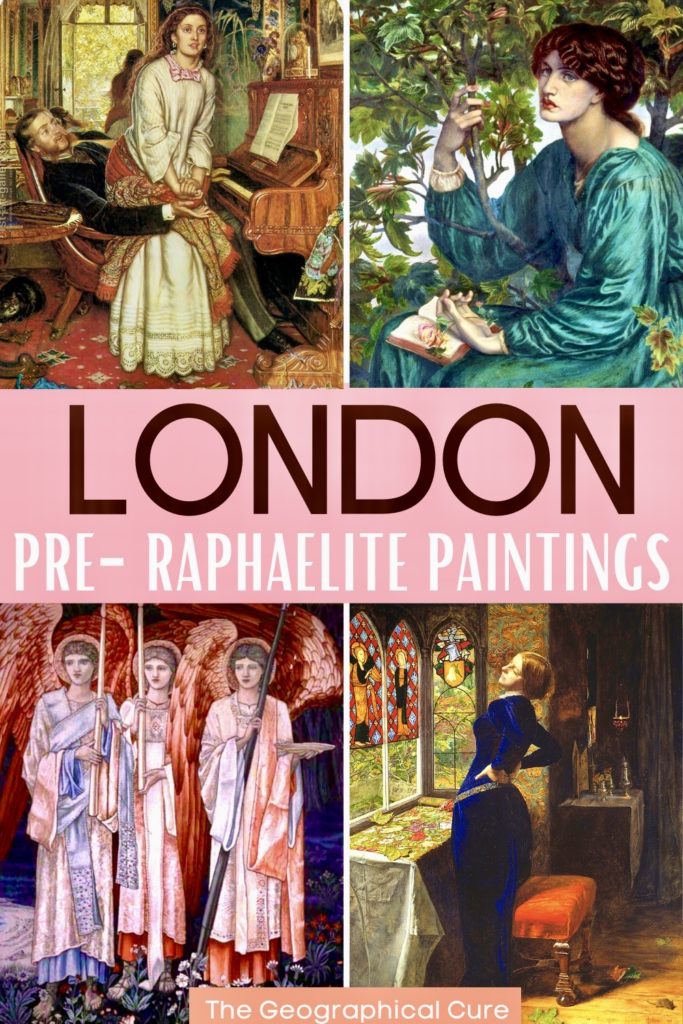Are you a fan of the Pre-Raphaelite artists traveling to London? If so, this guide’s for you. I take you on a tour of the most famous Pre-Raphaelite paintings in London and tell you which museums they’re in.
The Pre-Raphaelites were a group of Victorian radicals who were inspired by medieval art, literature, and nature. They aimed to shake up the stuffy Victorian establishment.
The Pre-Raphaelites had a strong aesthetic, which is instantly recognizable. It was typified by a jewel-like palette, exquisite attention to detail, and striking representations of women.
If you want to see the Pre-Raphaelites’ most famous paintings, which are just gorgeous, London is where you’ll find them.
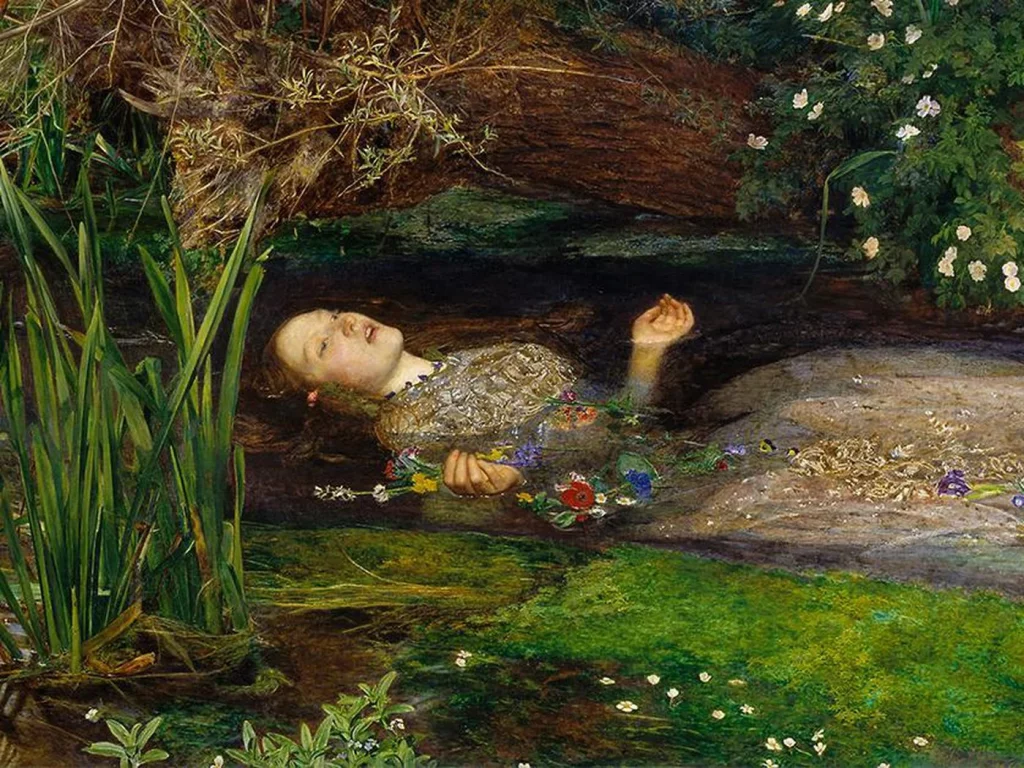
Overview of The Pre-Raphaelite Movement
The Pre-Raphaelite Brotherhood was formed in 1848 by three disenchanted students of the Royal Academy of Art — William Holman Hunt, Dante Gabriel Rossetti, and John Everett Millais. Later, Edward Burne-Jones and Ford Maddox Brown joined the group. When they assembled for the first time, their average age was just 20.
These bad boys were repelled by the state of art and society. They disliked the entrenched teaching methods of the academy and the trite genre paintings it championed.
Instead, the Pre-Raphaelites wanted to counter the brutal world of the Industrial Revolution and turn back the clock to an earlier and purer time in history.
They formed a secret society. They wanted nothing less than to create a new form of British art. And, in fact, many art historians now think the Pre-Raphaelites were Britain’s first modern art movement.
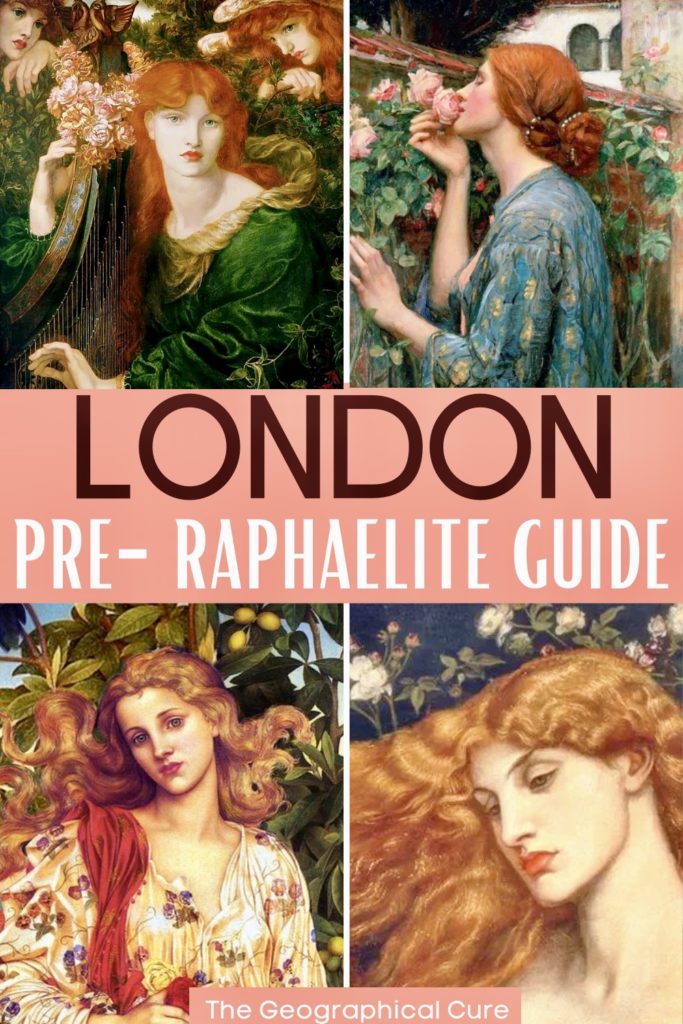
The group used the word “Raphael” as part of their name. Raphael was one of the most famous painters of the High Renaissance.
But they didn’t particularly admire Raphael, and disparaged his saccharine portraits.
The Pre-Raphaelites preferred art that pre-dated the Renaissance and its classicizing approach. They considered classicism all too boring.
The Pre-Raphaelites also despised the fustiness and conservatism of academic painting in London. They mocked Joshua Reynolds, head of the Royal Academy, as “Sir Sloshua.” The group used the word “sloshy” to refer to art that was lax and conventional.
Instead, the Pre-Raphaelites were inspired by the Gothic Revival, which in turn was inspired by late Medieval art. They adopted a bright color palette akin to stained glass windows.
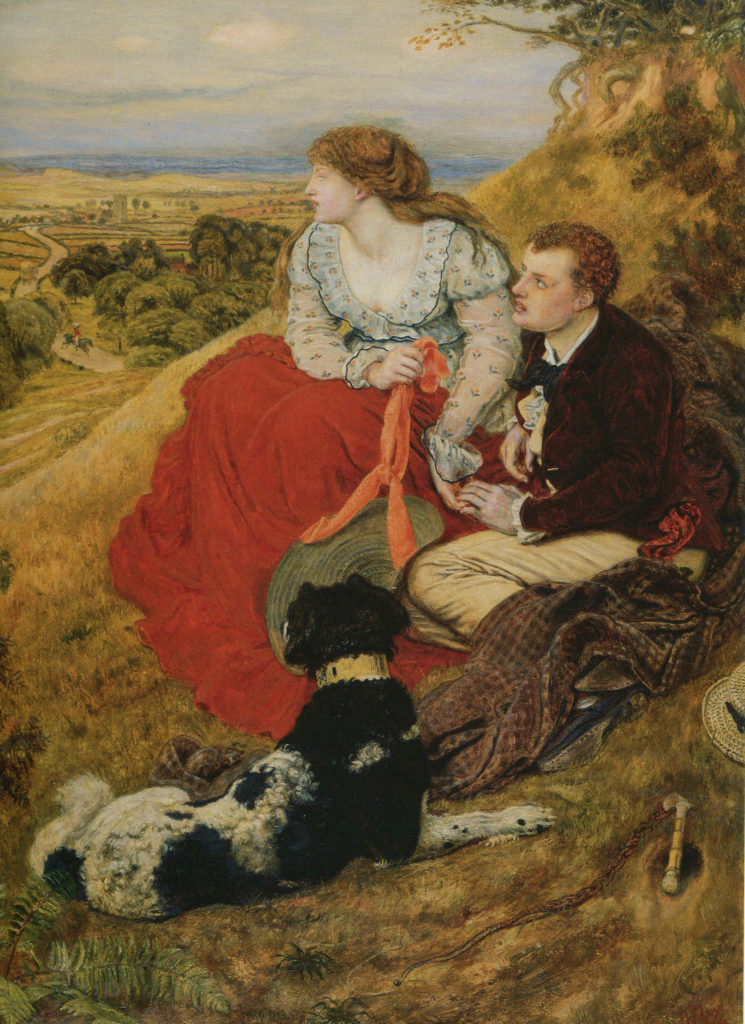
The Pre-Raphaelites were also an idealistic brunch. In an era marked by social ills, they sought the moral high ground and a return to nature and simpler times.
They took painting seriously and sought to impart a sincere message of renewal. They wanted to their paintings to tell a story and prompt viewers to think hard about important societal issues and embrace purity over corruption.
The Pre-Raphaelites were inspired by literature, including works by Dante, Shakespeare, Chaucer, Keats, King Arthur legends, and Greek mythology. They embraced ideals of heroism and chivalry and fought against the moral hypocrisy of their era.
The group’s paintings are thus characterized by nostalgia, Arthurian costumes, and literary references. But they’re also somewhat cinematic in nature, with their glossy images grabbing the viewers’ attention.
When the Pre-Raphaelites launched their new form of art, they met with immediate resistance. Their paintings were viewed as shocking. One critics called a Rossetti painting a “provokingly clear monstrosity.”
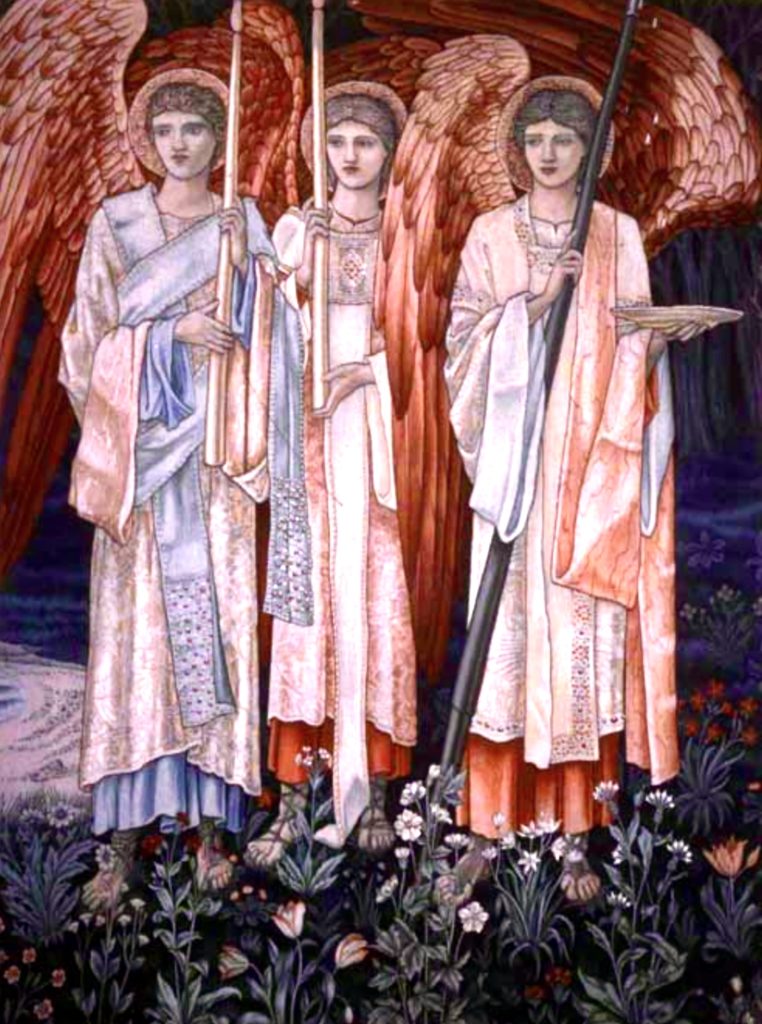
Critics didn’t like the Pre-Raphaelites crystalline flat surfaces, their jewel-like colorization, or the moralizing agenda. They thought they were precocious upstarts, without the rigor of “real” artists.
The group was rescued, for a time, by the writer John Ruskin. He was an art critic and a supporter of the notion that painters should faithfully document nature.
Ruskin believed that painting could tackle the subject of good vs. evil. He thought the pure-souled images of the Pre-Raphaelites might lay “the foundation of a school of art nobler than the world has seen for three hundred years.”
By the early 1850s, the official Brotherhood was gone. But its ideals and aesthetic were inherited by succeeding generations.
In 1853, Burne-Jones and William Morris became part of the second generation of Pre-Raphaelites. They were mentored by Rossetti. They kept the saturated palette and exhaustive detail of the early Pre-Raphaelite paintings.
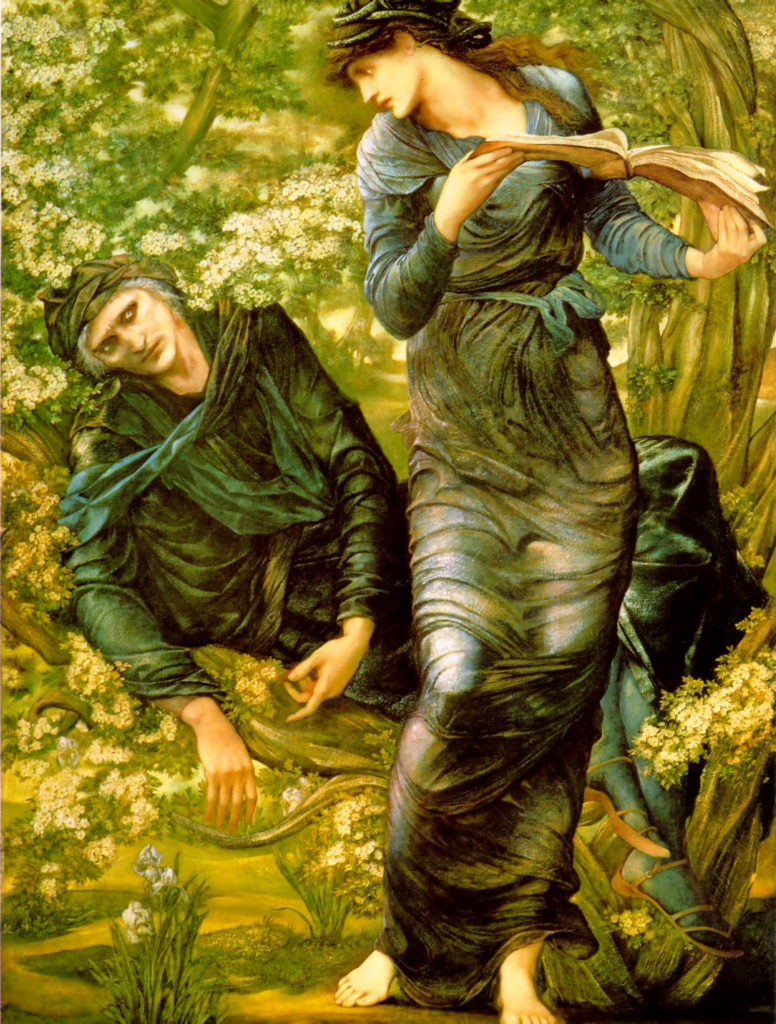
Burne-Jones had a penchant for dreaming. He sought to create a world that was a “beautiful romantic realm of something that never was, never will be.”
The second generation works were less moralizing. In fact, some of their paintings were rather racy.
They featured haunting red headed beauties with great masses of hair and a solemn eroticism. The women blended sexiness and soulfulness, an ideal of feminine beauty that is still alive today.
By 1860, the Ruskinian precision to nature had ebbed, replaced with an emphasis on sumptuous color and splendor.
Eventually, the Pre-Raphaelite works became more decorative. Artists like Burne-Jones designed stained glass and tapestries and illustrated books. This gave rise to the Arts & Crafts Movement.
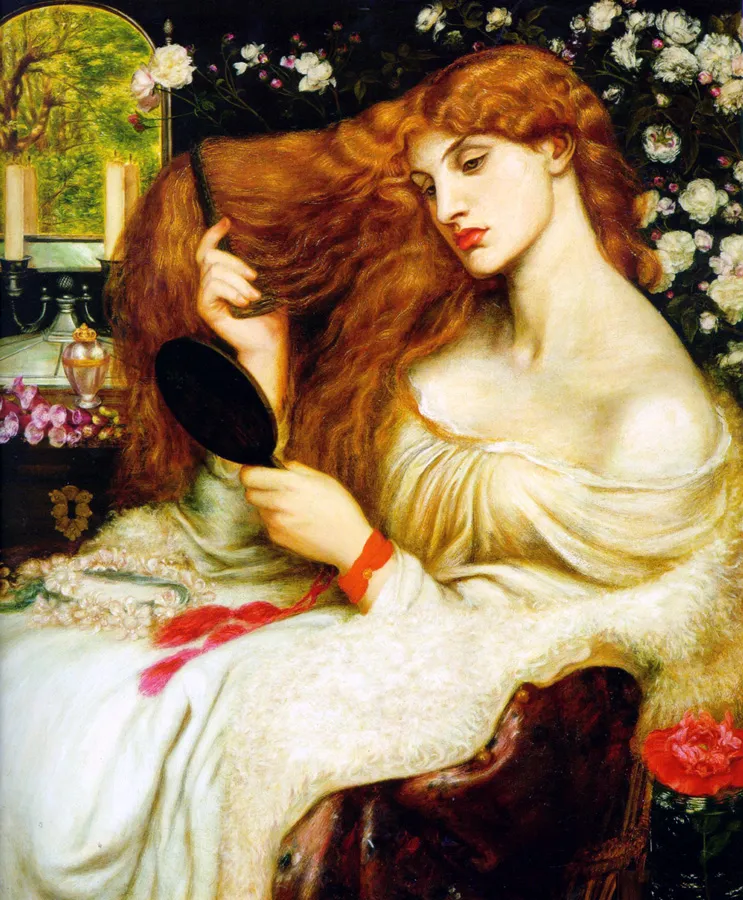
For the next century, the Pre-Raphaelites fell into critical disfavor. They were ridiculed as sentimental and despised for their figurative work when abstraction was in vogue.
The group’s fortunes were revived by a pioneering Pre-Raphaelite show at the Tate Britain in 1984. It was the most important exhibition ever devoted to the movement.
The Tate portrayed the Pre-Raphaelites not as mawkish painters, but as Victorian radicals who reacted against convention and boldly tried to reform art.
Today, you can see the Pre-Raphaelite influence everywhere, from storytelling specialists like George R.R. Martin to floaty ethereal fashion looks.
The Pre-Raphaelites were a distinctively British art movement. They produced a relatively small body of art works.
Most of the most seminal Pre-Raphaelite paintings can be found in London or the United Kingdom. There are almost no works in the United States, save for a few in the Delaware Museum of Art and the Harvard Art Museums.
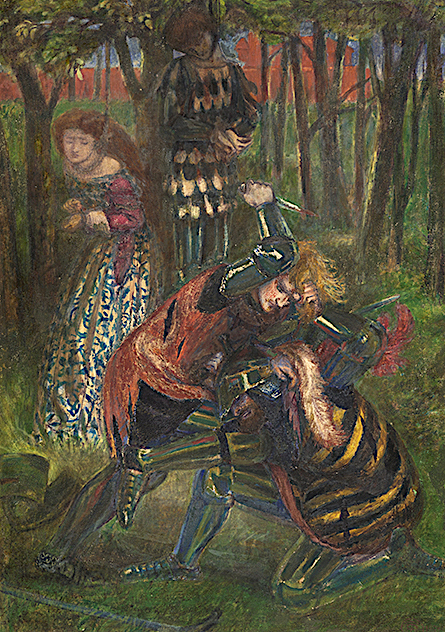
Famous Pre-Raphaelite Paintings To See In London
Here are 18 Pre-Raphaelite paintings you can see in London. I also tell you which museum they’re housed in.
1. Rossetti, Death of Breuze Sans Pitie, British Museum
This beautiful early Rossetti watercolor was just acquired by the British Museum in 2019. It was gifted by art historian John Christian.
For much of the 20th century, the painting was thought to be lost. It was only rediscovered in 1993 when it was auctioned at Christies.
It’s not your typical Rossetti painting with a sensual red haired beauty. Instead, this rather rare and sinister painting depicts violence and death.
There’s a knife fight between two men from Arthurian tales. A terrified woman looks on and a dead man hangs from a tree.
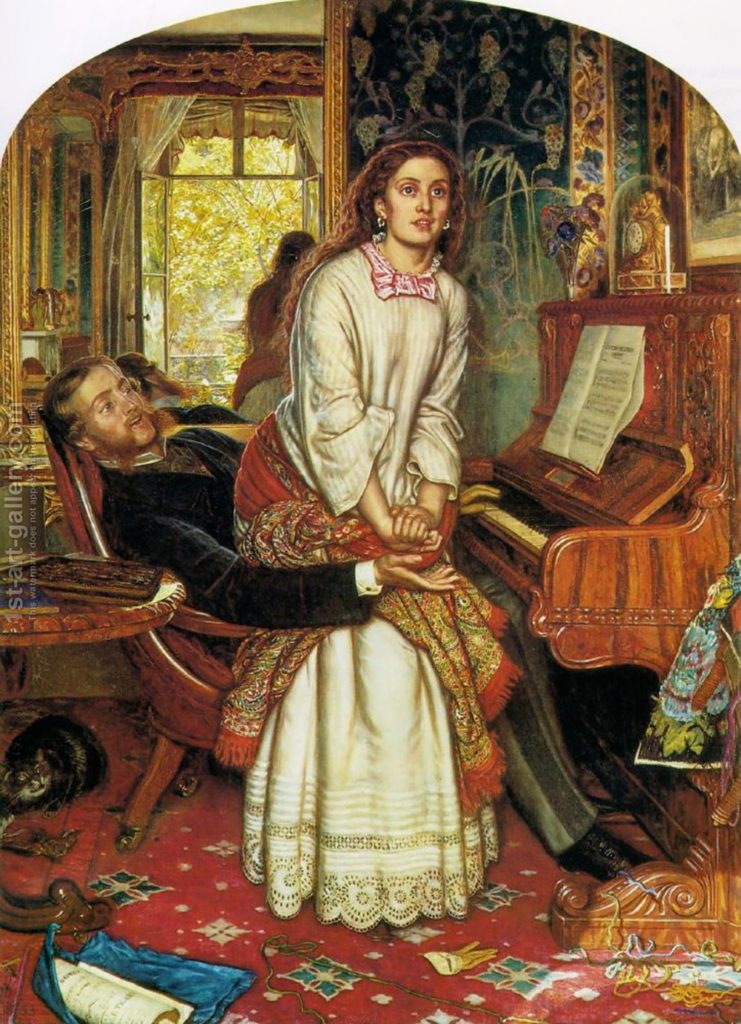
2. Holman Hunt, The Awakening Conscience, Tate Britain
This famous Pre-Raphaelite painting looks fairly innocent. But it’s not. It’s full of symbolism, and an exploration of morality, sex, and prostitution.
The flame haired woman is likely the man’s mistress. She’s depicted in her undergarments and not wearing a wedding ring.
A fallen glove on the floor symbolizes her fallen predicament. A tangled bunch of yarn also suggests that the woman is trapped.
She has a strange look on her face, almost one of revelation. The light behind her suggests she sees a path to redemption.
It’s a classic early Pre-Raphaelite painting in that it requires you to read the clues and engage in a subject you might not want to think about.
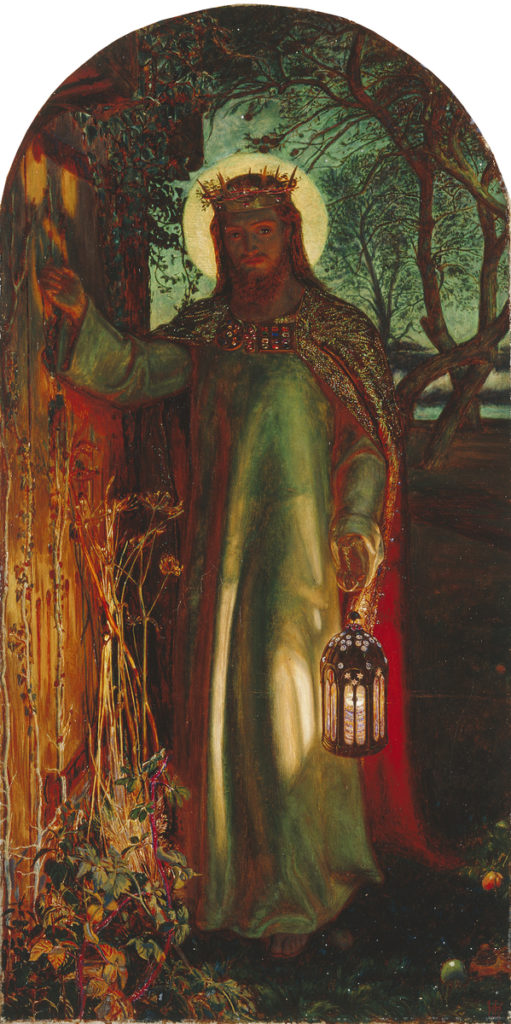
3. Holman Hunt, The Light of the World, St. Paul’s Cathedral
One of London’s most famous Pre-Raphaelite paintings in inside St. Paul’s Cathedral in the Chapel of Saints Erkenwald and Ethelburga.
It’s a beautiful altarpiece painted by William Holden Hunt called the Light of the World.
The painting depicts Christ in a dark wood. He’s holding a lantern and knocking at an overgrown door with no handle. The door is meant to symbolize the human soul, which may or may not respond to Christ’s teaching.
In 1905, the painting traveled the world and achieved cult status. In its day, it was viewed by more people than any other painting in the world.
>>> Click here to book a ticket for St. Paul’s Cathedral
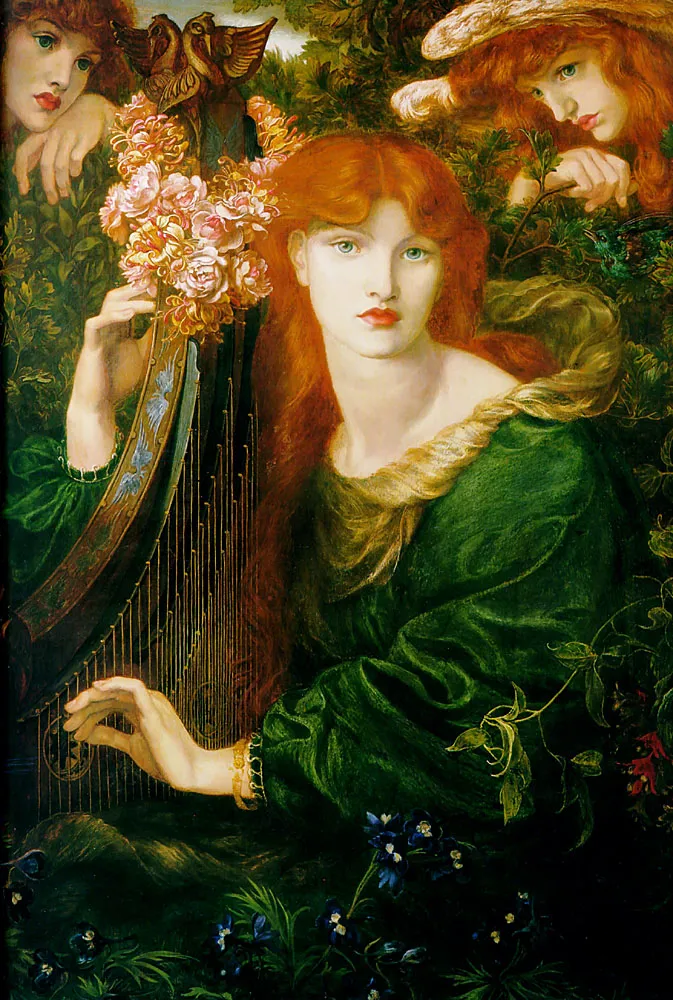
4. Dante Gabriel Rossetti, La Ghirlandata, Guildhall Art Gallery
The title of Dante Gabriel Rossetti’s La Ghirlandata is translated as “The Garlanded Lady” or “The Lady of the Wreath.” The model is Alexa Wilding.
The painting is interpreted as an embodiment of love and beauty.
The artist depicts Wilding playing a harp. She’s surrounded by angels, flowers, and luscious green foliage. Her green dress blurs into the landscape.
Painted in 1873, La Ghirlandata belongs to the strongly aesthetic, sensual phase of Rossetti’s later career. Between 1871–74 Rossetti produced several paintings of women playing musical instruments.
For more information, here’s my complete guide to the Guildhall Art Gallery.
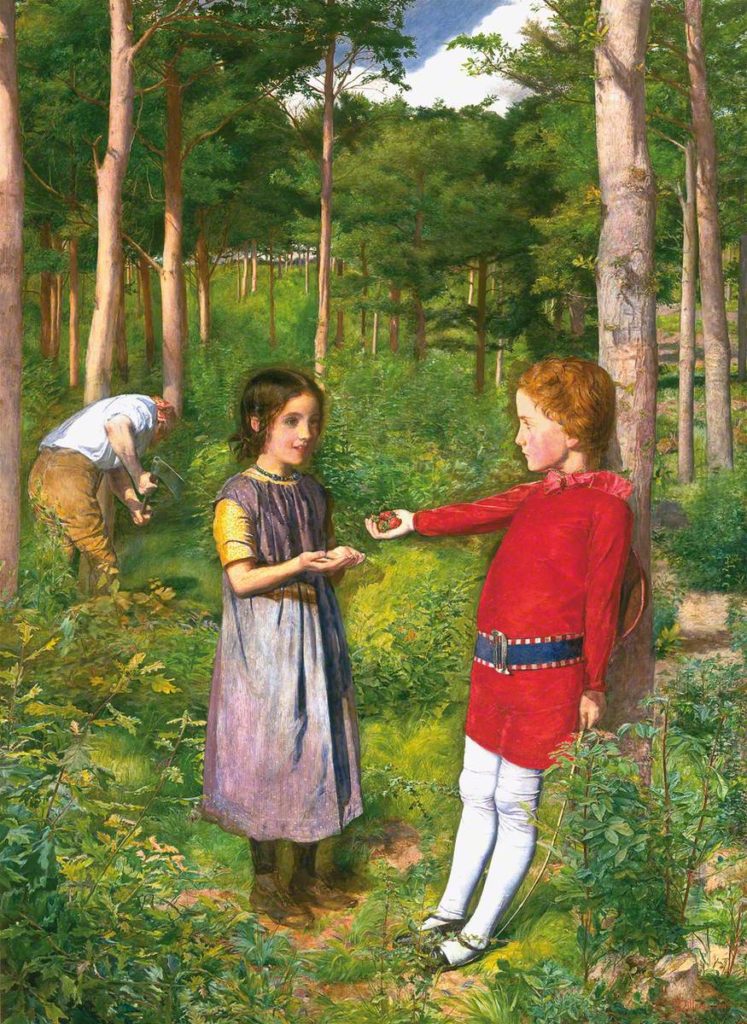
5. Millais, The Woodman’s Daughter, Guildhall Art Gallery
For this painting, Millais drew inspiration from a poem by his friend Coventry Patmore. The poem tells a sad tale of how the friendship between an innocent girl and a rich squire’s son ends in tragedy.
It’s a classic Pre-Raphaelite tale of tragic love and seduction. The pair look sweet in the painting, though the boy has a rather stern look. The offering of fruit seems to foreshadow a future tryst.
According to the poem, they have a love affair years later. It can’t end in marriage because of the pair’s different social ranks. The girl gives birth to an illegitimate child, drowns the baby in a pool, and goes insane.
Millais painted the landscape background outdoors and added the figures in his studio. It features the brilliant green, purple, and red colors he favored.
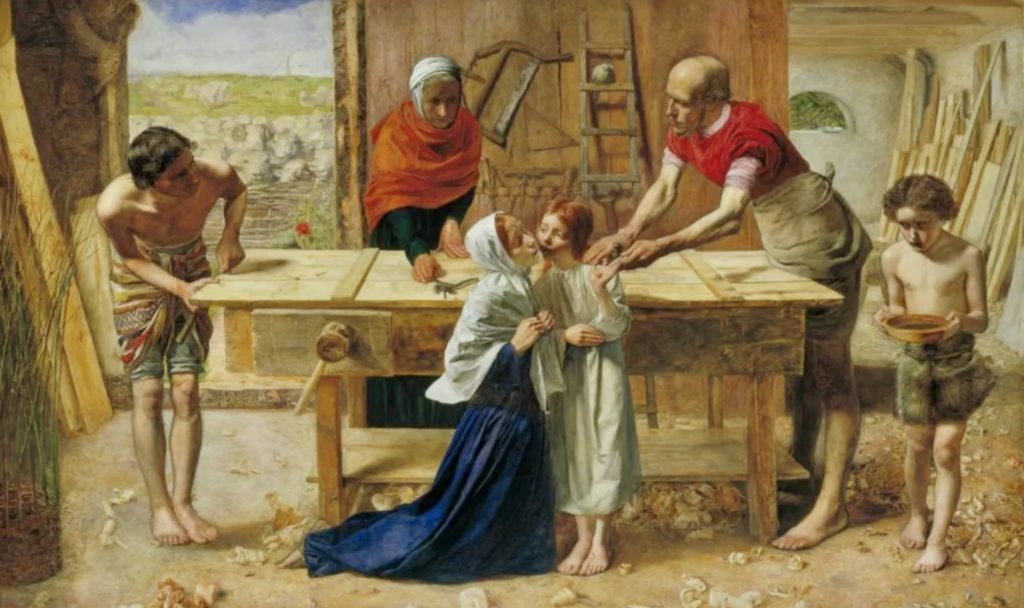
6. Millais, Christ in the House of his Parents, Tate Britain
This painting sparked controversy and was despised the instant it was unveiled. Instead of a reverential scene, Millais painted the holy family with gritty realism and no idealizing. It was deemed blasphemous.
Bathed in light, the painting depicts a red headed Mary tending to a red headed Christ after he cuts himself. They’re in a working class carpenter shop. You can see dirty toenails and hands red from working.
Christ’s bloody hand foreshadows the stigmata that will follow. A white dove representing the Holy Spirit is perched on a ladder.
Charles Dickens was one of the most prominent critics, saying it was “horrible in its ugliness.” But his view was likely the product of class prejudice in the Victorian era.
READ: Guide To The Tate Britain
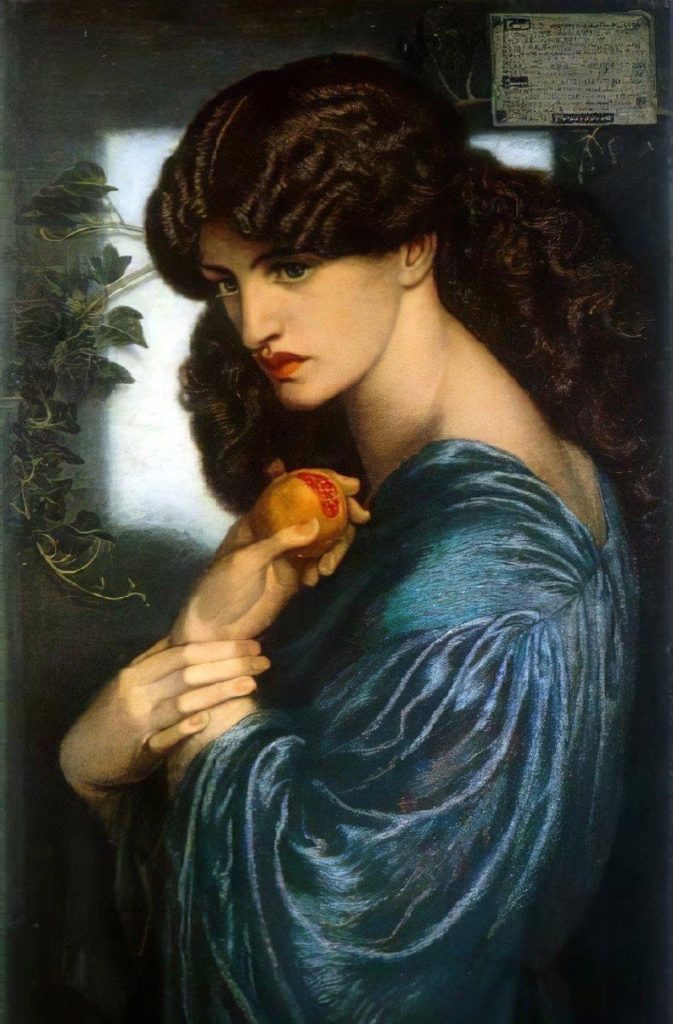
7. Rossetti, Prosperine, Tate Britain
Prosperine is one of Rossetti’s best know works. There are 8 versions. The model is the raven haired Jane Morris, the wife of William Morris.
In Greek mythology, Prosperine is abducted by Pluto and hidden away in the underworld, condemned to be his wife.
The painting reflects this gloomy world. Prosperine appears thoughtful and melancholic. She holds a pomegranate in her hand, from which she took a single bite and in doing so became a prisoner.
The mood of the painting is unease. This is conveyed by the awkward grip of her hands and the unnatural bulge at the back of her neck. Even the creases in her dress seem a bit sinister.
Jane was a frequent model for Rossetti. They enjoyed an intimate relationship. So intimate that some think the painting is a metaphor for the Williams’ unhappy marriage. Jane, like Prosperine, was trapped and longed for her freedom.
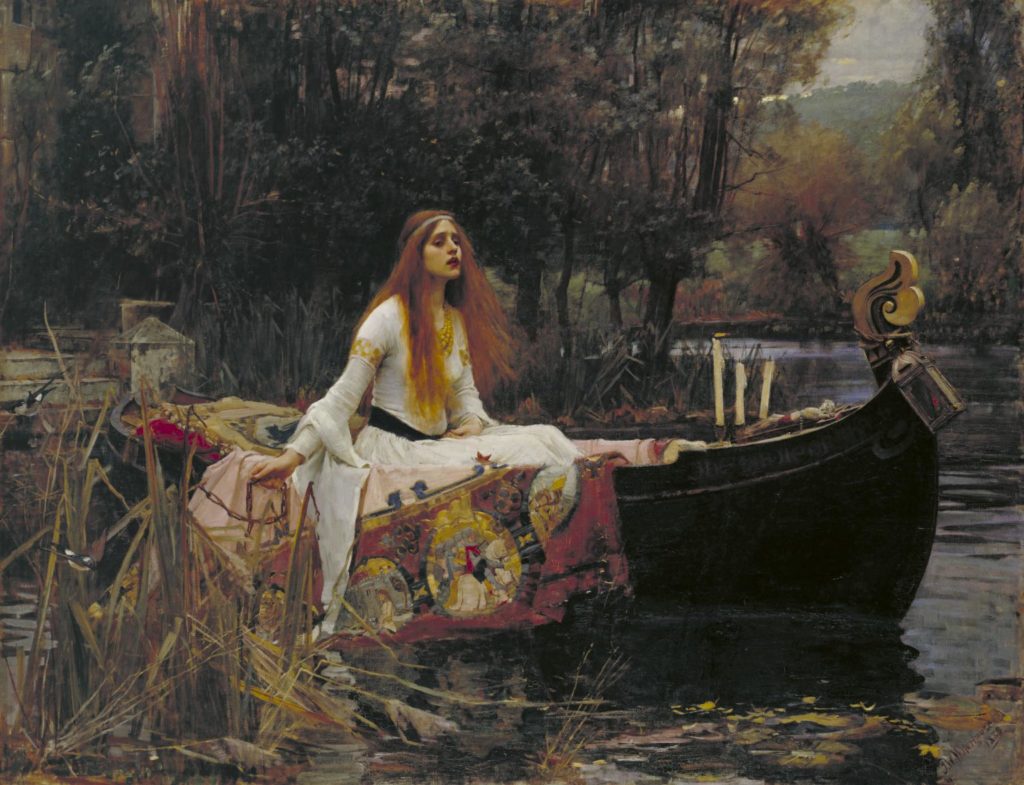
8. Waterhouse, The Lady of Shallott, Tate Britain
Waterhouse’s The Lady of Shalott is an famous late Pre-Raphaelite masterpiece housed in the Tate Britain. It’s considered the last true Pre-Raphaelite painting.
Waterhouse’s painting is one of visual splendor, with bold and brilliant color. Waterhouse uses an almost impressionistic style, lending delicacy to the painting.
The subject comes from Lord Alfred Tennyson’s Arthurian poem of the same name. Because of a curse, the lady is forbidden from looking out her window, upon pain of death.
One day, she sees Lancelot in a mirror and is immediately smitten. To meet him, she leaves her castle and rides a boat down to Camelot, knowing that it will likely kill her.
The curse kicks in and she dies before reaching the shore. Her demise is hinted at by a crucifix and three candles in the painting.
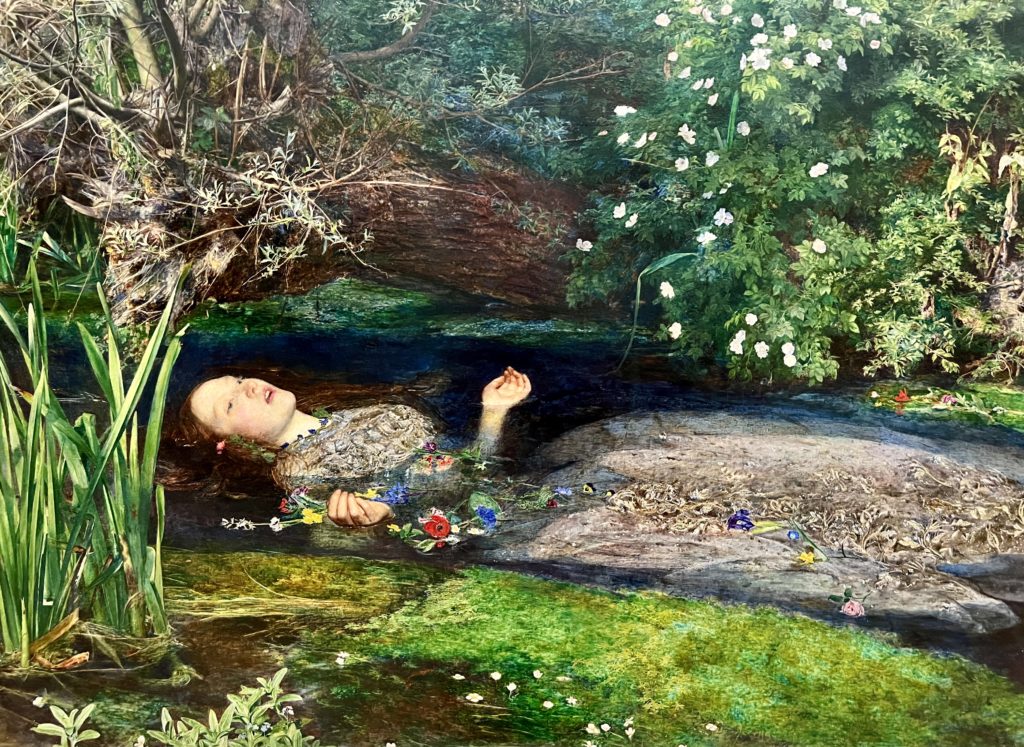
9. Millais, Ophelia, Tate Britain
Ophelia is perhaps the most famous of all Pre-Raphaelite paintings. It has the group’s trademark bright colors. It’s a haunting and morbid vision, conveying a tragic theme of wasted youth.
The painting depicts the death of the pale and dark haired Ophelia, a character in Shakespeare’s Hamlet. Ophelia is driven mad with grief when Hamlet murders her father.
She falls into a stream and drowns, floating down a river in a billowing white dress. Her hands grasp the air and her eyes are half opened.
Millais spent months painting the painting’s lush landscape, strewn with symbolic flowers, outdoors. Never before had an artist produced a painting so realistic and with such vivid colors.
In its day, Ophelia was regarded as at the most accurate and elaborate study of nature ever made. The model, Lizzie Siddall, posed in a bathtub and contracted pneumonia.
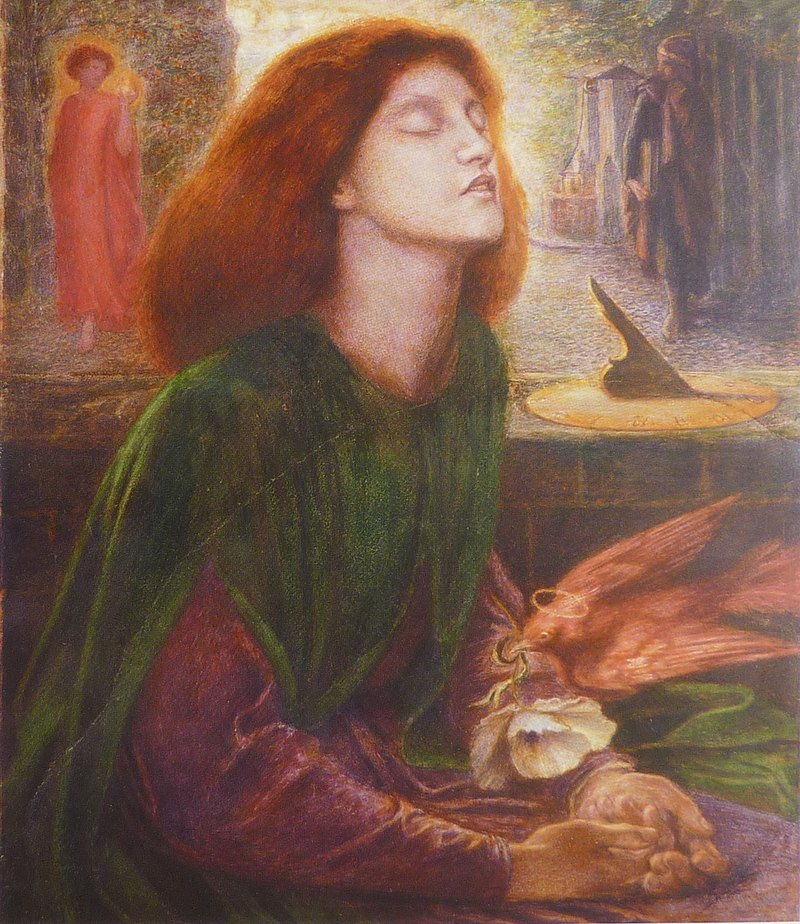
10. Rossetti, Beata Beatrix, Tate Britain
This Pre-Raphaelite masterpiece was inspired by Dante’s Vita Nuova. That poem tells the story of Dante’s idealized and unrequited love for Beatrice.
The painting is a portrait of Rossetti’s wife, Elizabeth Siddall, in the character of Beatrice. In the background, Dante gazes toward his love and wife who had died two years ago.
The work has a hazy, transcendental quality, like a dream or a vision. Beatrice is posed in ecstasy.
A halo seems to frame her red hair. Dante is sheltered in the wings of love.
The painting is filled with symbolic references. A bird drops a white poppy into her hand, a symbol of death. The dove and the figure of love are red, the color of passion. The time of Beatrice’s death is seen in the sundial.
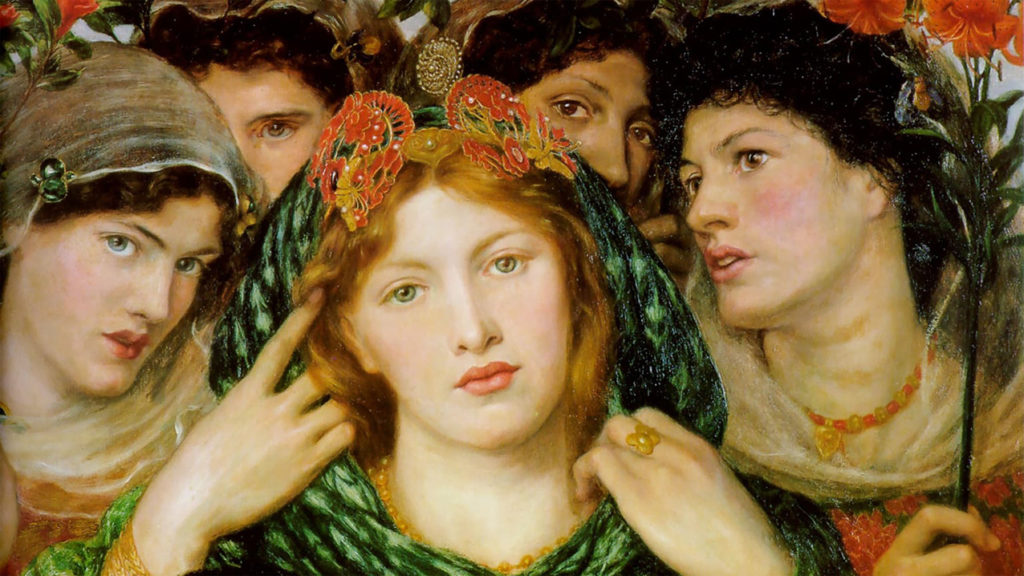
11. Rossetti, The Beloved, Tate Britain
In this painting, Rossetti channels the Song of Solomon. It’s a biblical story celebrating sexual love.
A bride, accompanied by her bridesmaids, is shown lifting her veil. She is about to display her beauty to her husband for the first time.
The painting has exotic elements — from the bride’s headdress to the young black girl.
The painting may have been inspired by Manet’s Olympia, in Paris’ Musee d’Orsay, which the artist had seen.
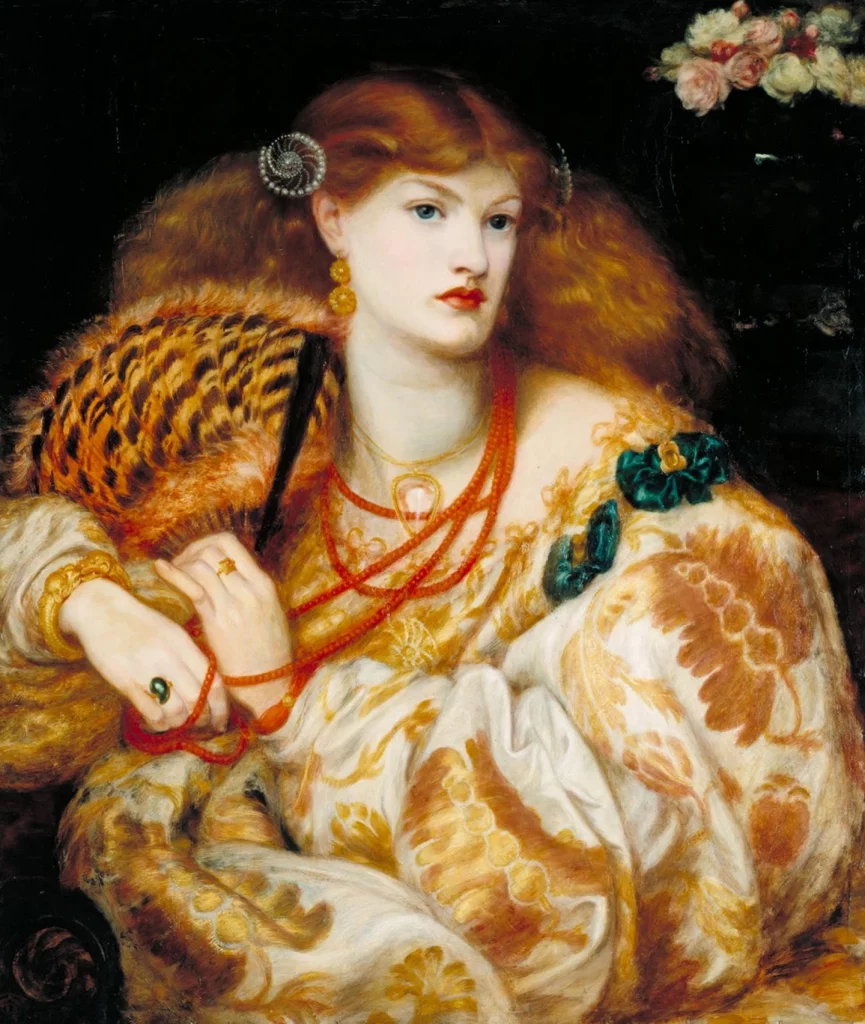
12. Rossetti, Monna Vanna, Tate Britain
This is one of a series of Rossetti’s portraits of beautiful and sensual women, produced in the mid 1860s. The model is Alexa Wilding, a woman who sat for some of Rossetti’s most famous works.
She has the flowing auburn hair that the Pre-Raphaelites loved. Her red coral necklace appears frequently in Rossetti’s pictures of women.
Rossetti first called the painting Venus Veneta, to indicate it was a portrait of a Venetian woman. But Rossetti changed the name to Monna Vanna, which means vain woman. The title was taken from Dante’s 13th century poem Vita Nuova.
Rossetti considered Monna Vanna to be one of his best works. He declared it “the most effective as a room decoration that I have ever painted.”
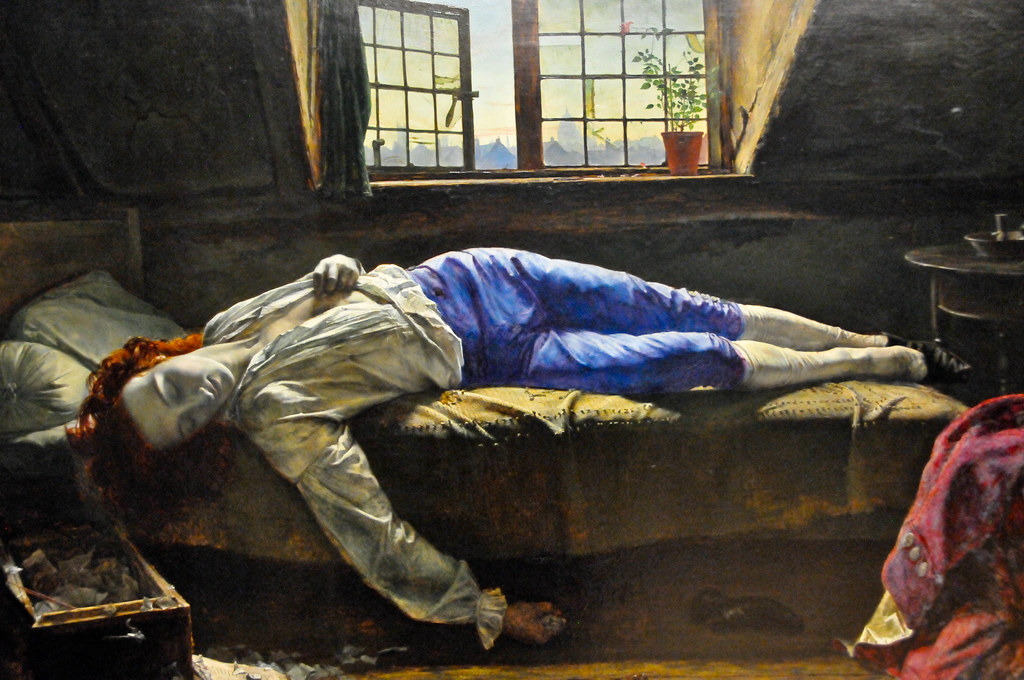
13. Henry Wallis, Chatterton, Tate Britain
Chatterton is a highly romanticized painting. It created a sensation when it was exhibited at the Royal Academy. It’s an example of the Pre-Raphaelite approach to history painting.
Thomas Chatterton was a poet and melancholy writer of Gothic themes. Despairing of his lack of literary success, he committed suicide at the age of 17 by swallowing arsenic.
Wallis’ painting shows the horrors of youthful death. The pale still body of Chatterton lies on a bed. His head and right arm dangle loosely over the edge, his tattered papers and the poison vial beside him.
His white shirt and stockings help to silhouette the figure against the darker background. The vivid purple of Chatterton’s knee breeches and his reddish hair grab the viewer’s attention.
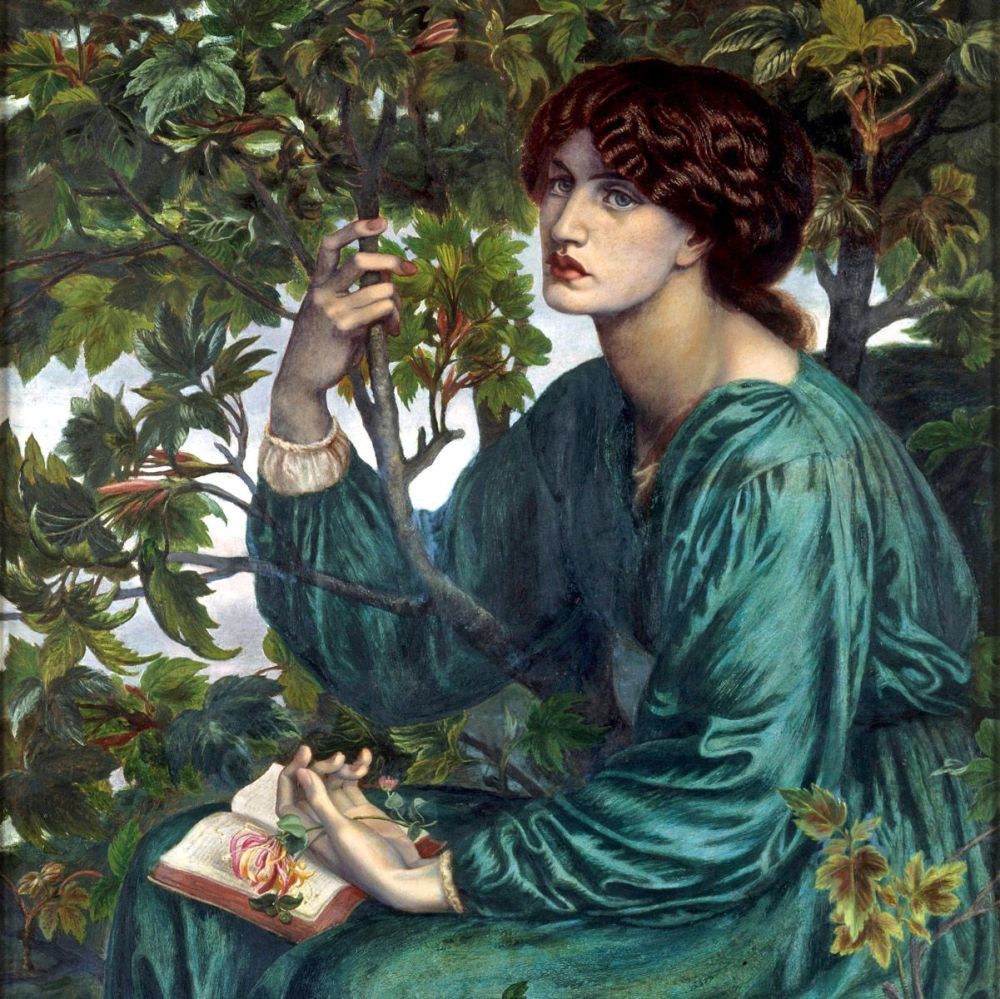
14. Rossetti, The Day Dream, Victoria & Albert
Rossetti painted The Day Dream just two years before his death. It’s considered his last great painting and is housed in the Victoria & Albert, which is one of London’s best museums.
Once again, Rossetti depicts his muse and lover Jane Morris, who had became an obsession for Rossetti.
She’s a vision in teal green, sheltered in a green sycamour landscape. She’s clad in a dress that’s similar to the one she wore in Prosperine.
She seems immersed in her thoughts, gazing off at something that caught her attention. But one wonders if the day dream is one of Jane’s or of Rossetti himself.
In the landscape, you can see honeysuckle, which is a symbol of love. It could signify their illicit affair.
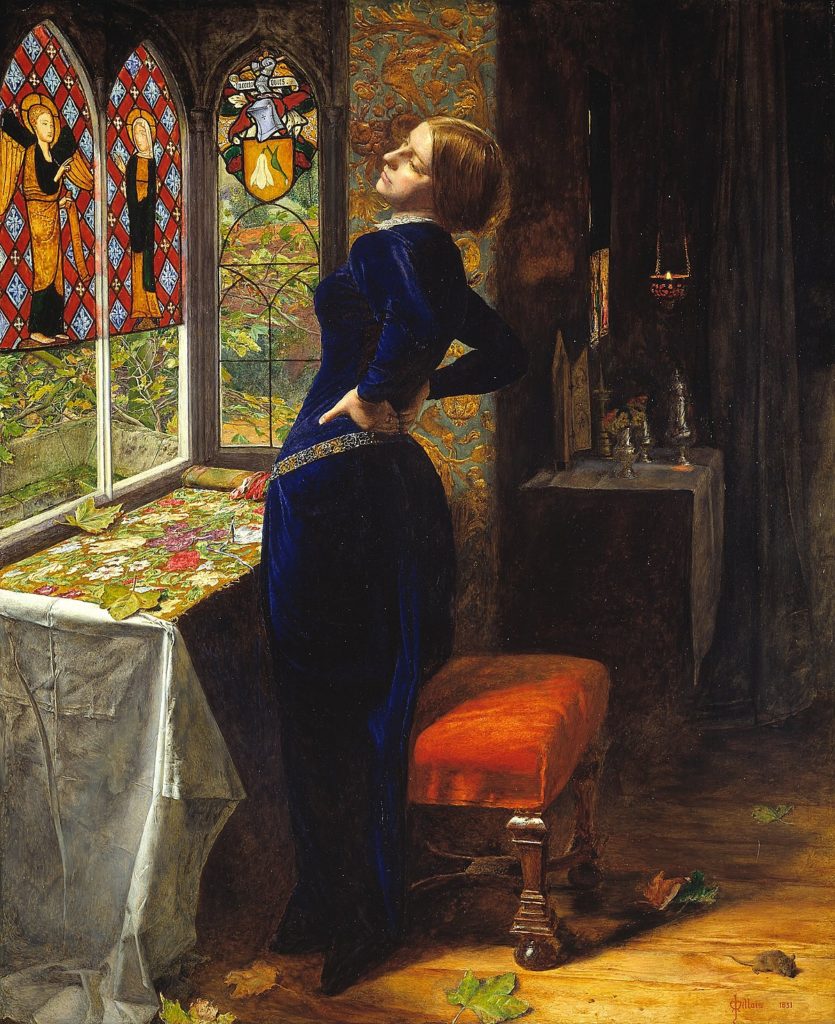
15. Millais, Mariana, Victoria & Albert
This Millais painting was based on a poem by Tenyson. A woman named Mariana also appears in Shakespeare’s Measure For Measure.
In the painting, a medieval woman stands alone in a brilliant blue dress, seemingly waiting for death. She is biding her time, in a remote farmhouse, hoping her lover will return.
Mariana may be waiting in vain, her lover a disloyal cad who rejects her because her dowry was lost at sea. Her expression is one of frustration or exasperation. Her misery grows as time passes, signified by the fallen leaves.
Millais’ colors are gorgeous with the blue gown contrasted with luminous reds and golds.
The painting has been compared to an annunciation scene, in which the angel Gabriel tells Mary she is pregnant with Christ. And, in fact, the annunciation is depicted in the stained glass windows she stands in front of.
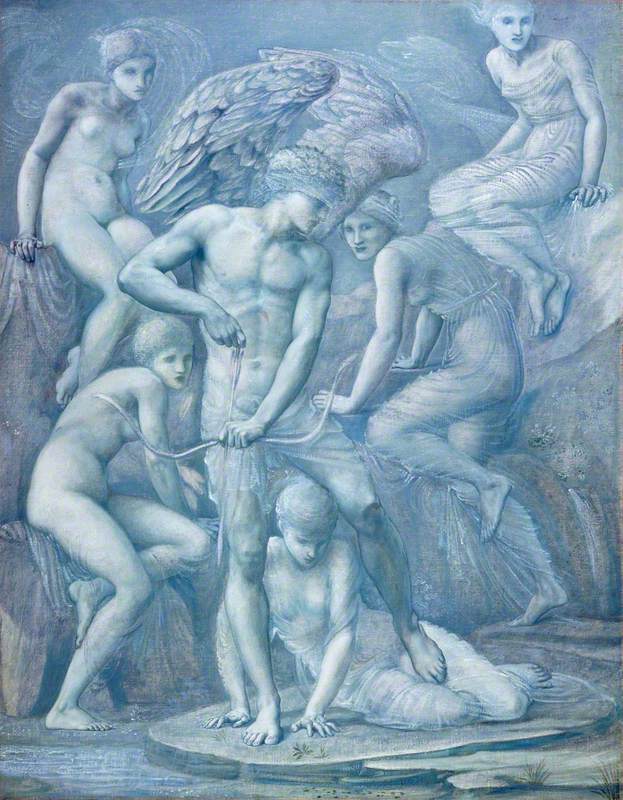
16. Burne-Jones, Cupid’s Hunting Fields, V&A
In this beautifully drawn piece, a blindfolded Cupid is in the center of the painting. He shoots arrows at his female victims.
The women are either naked or partially clothed in translucent drapery. They’re rendered in a pale pastel palette mean to evoke a fantasy world. This palette would influence James Whistler, a painter in the Aesthetic movement.
Cupid’s Killing Field is a subject that Burne-Jones drew or painted many times in his career.
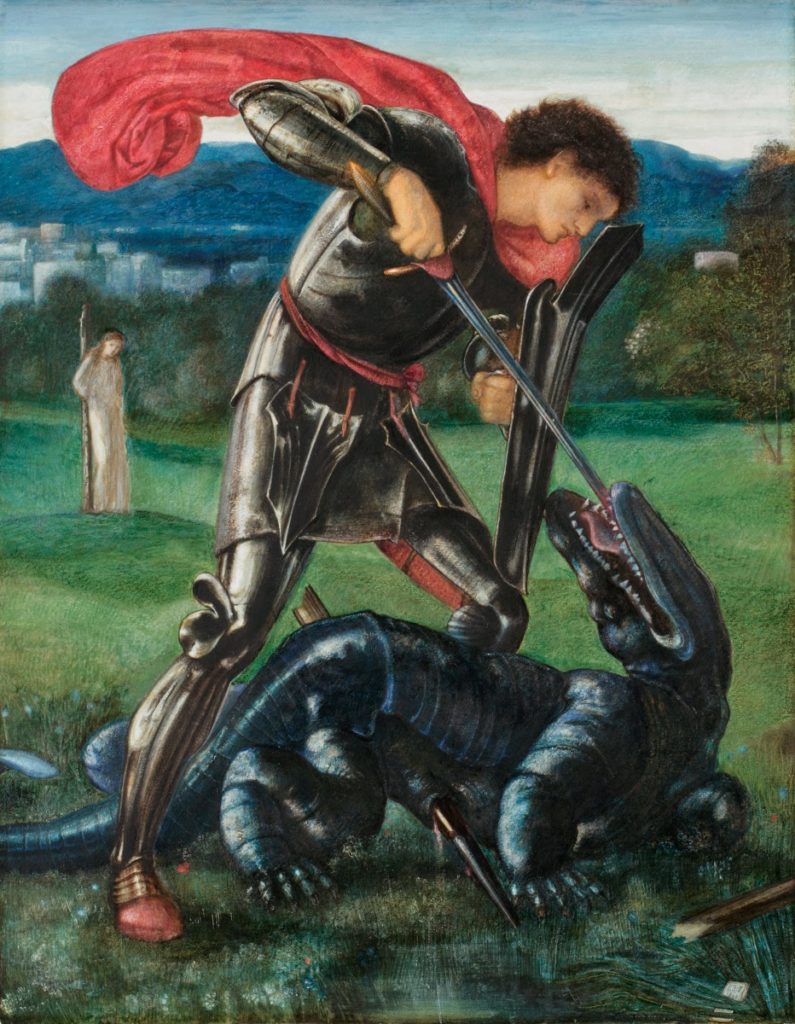
17. Burne-Jones, Saint George & the Dragon, William Morris Gallery
In this densely colored painting, Burne-Jones depicts the romantic story of the chivalrous knight St. George. He became England’s patron saint and a favorite subject of the Pre-Raphaelites.
In the fairytale, a town is besieged and attacked by a plague bearing dragon. The town is forced to offer a person once a year to keep the dragon at bay.
When the town princess is chosen as the sacrifice, there’s panic. But St. George steps in, slays the dragon, and marries the princess.
Burne-Jones doesn’t tell a violent tale. St. George rather matter of factly takes a knife to the subjugated dragon. The princess looks on it the background.
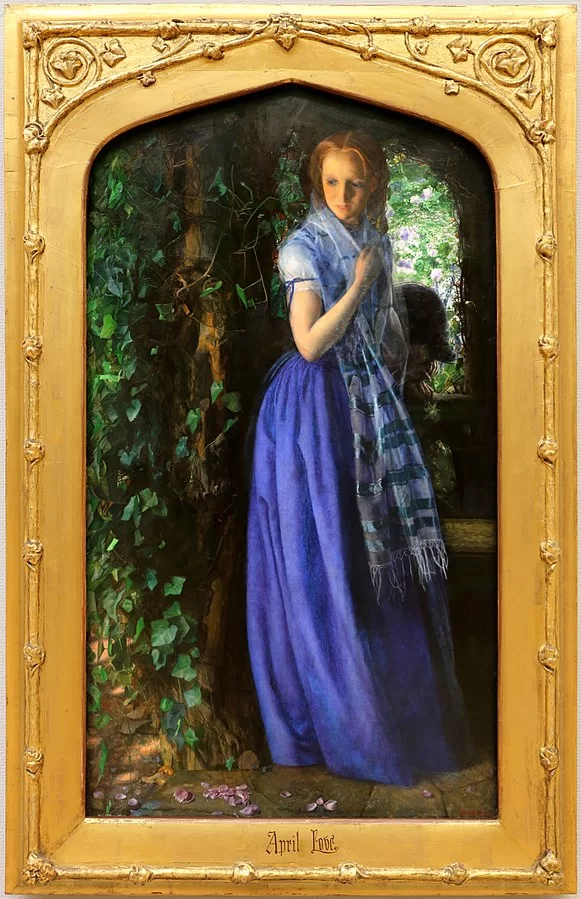
18. Arthur Hughes, April Love, Tate Britain
April Love is a beautiful and famous painting in London by Arthur Hughes. It was purchased by William Morris from the Academy. It was also admired by Ruskin, who said it was “exquisite in every way.”
The scene is based on a poem by Tennyson, The Miller’s Daughter. The painting depicts a young lady in a purple dress and her lover. They are meeting in secret. He’s hidden in the shadows.
From the girl’s tears and pained face, you can tell that the couple will break up. It’s a story of young love and its inevitable end.
the Delaware Museum of Art and the Harvard Art Museums.
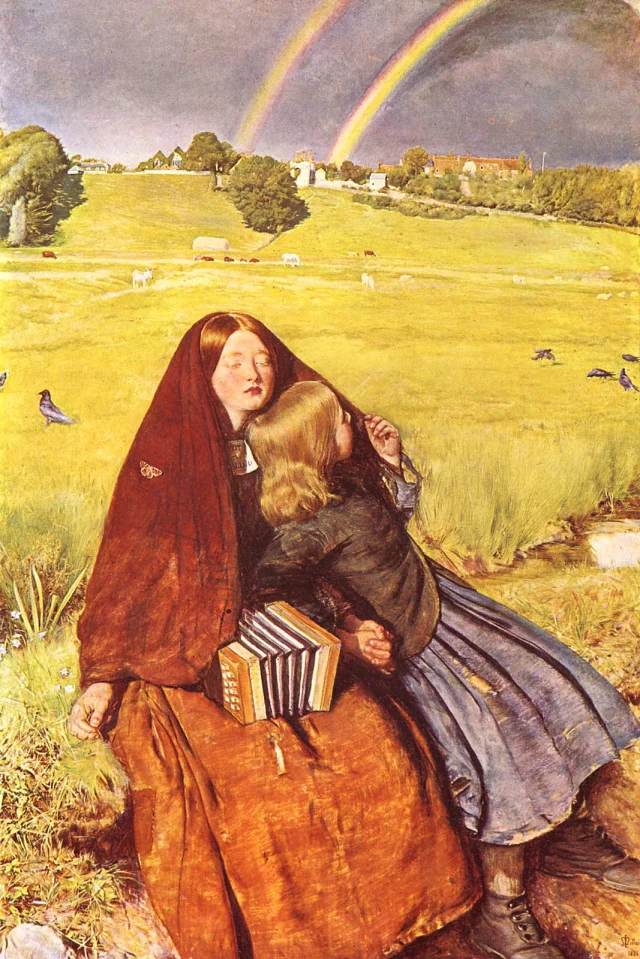
Love Or Hate The Pre-Raphaelites?
The Pre-Raphaelites seem to be either loved or hated. Most critics laugh at them. But, lately, audiences adore them.
Critics see their works as emotionally overwrought paintings, which relentlessly pile on symbolism and overly garish colors in a way that exhausts the viewer. They view the paintings as “hit you over the head” works of art that leave nothing to the imagination.
They believe the Pre-Raphaelites were the opposite of revolutionary, instead living in an old fashioned fantasy world of melancholy and angst. Their work was just a sticky mess of stuff, which was both moralizing and mawkishly sentimental.
Some critics think their work is demeaning to women. The Pre-Raphaelites often painted women as tragic dewy eyed muses who were fallen, which was sometimes interpreted as a visual cliche.
Those that love the Pre-Raphaelites are drawn to the teenage rebels who were talented, romantic, and read poetry.
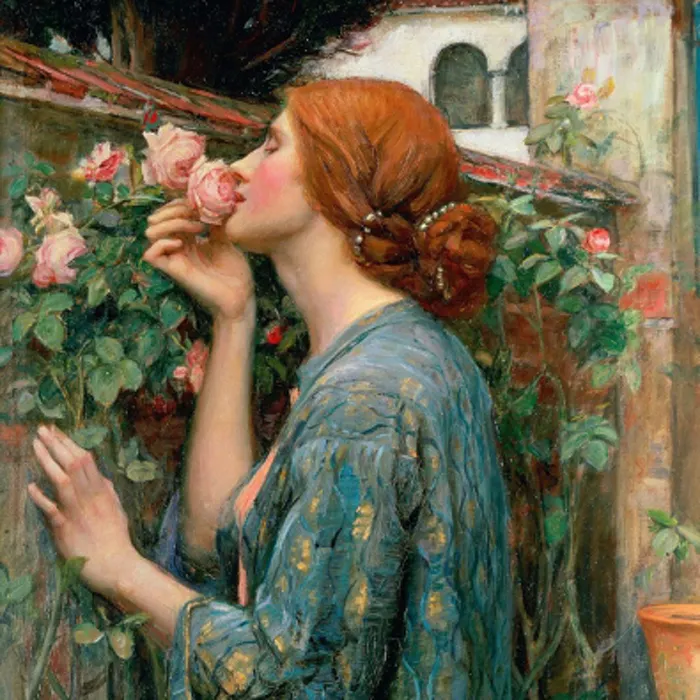
Plus, the artists could flat out paint with uncanny skill. You have to give them that. In a world where conceptual art is ubiquitous, it’s nice to admire works by people who could actually draw.
The Pre-Raphaelites muses were also quite modern and uninhibited by the prevailing social mores. Modeling helped them escape from domestic service and gave then an independent occupation.
The models operated almost as fashion models or celebrities in their own right. They influenced fashion by dressing in unstructured “hippy” dresses that were contrary to the corseted fashion of the day.
Some of the models bartered art lessons in return for services. They became artists in their own right and creative partners of the Pre-Raphaelites.
The Pre-Raphaelites were hugely influential. They rebelled against the academy more than a dozen years before the French Impressionist would do the same. They influenced other movements like the Aestheticism and Symbolism.
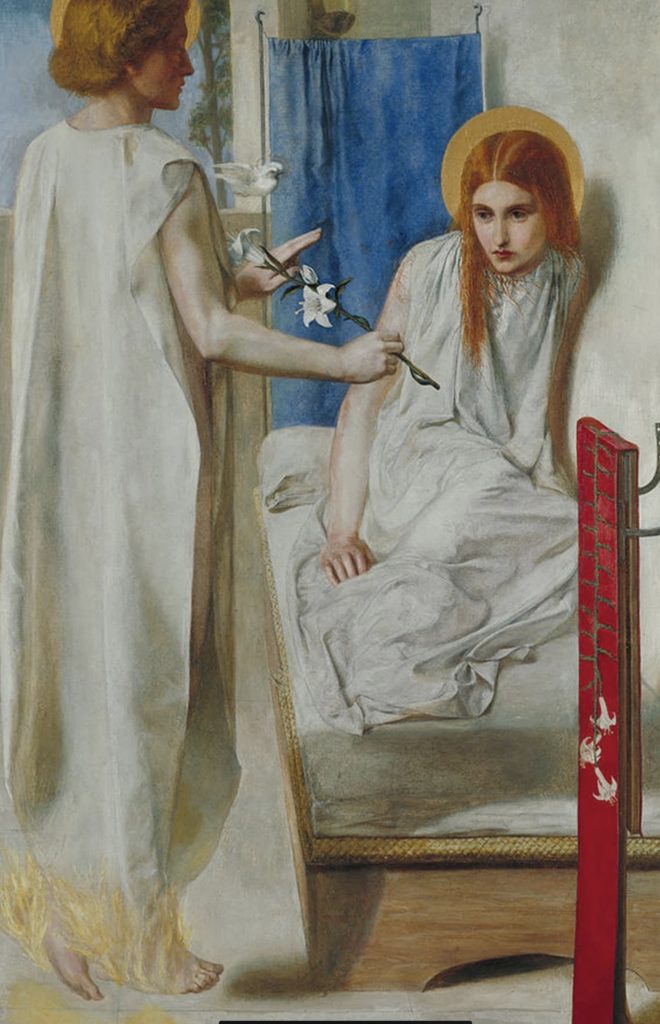
For myself, I like the Pre-Raphaelites. I think their paintings are gorgeous and, when contextualized, don’t seem like trite fairytales.
I’m drawn to the medieval world and like their romantic spirit. As a literary lover, I also find art with a penchant for myth, legend, and magical landscapes quite compelling.
Perhaps they didn’t dramatically rethink painting, like their esteemed French contemporary Edouard Manet. But they did paint “in plein air,” a mode of painting the Impressionists would later adopt.
And there seems nothing wrong to me with “escapist” paintings that portray an alternative literary world, rather than focusing on the harsh light of the modern day. Sometimes one needs a break.
In fact, Pre-Raphaelite art may be appealing precisely because it attempts to counteract the spiritual degradation and meanness of contemporary life. Their popularity has never been higher.
I hope you’ve enjoyed my guide to the Pre-Raphaelite paintings in London. You may enjoy these other London travel guides:
- 3 Day Itinerary for London
- 5 Day Itinerary for London
- Best Museums in London
- Harry Potter Places in London
- Guide to the National Gallery of Art
- Guide to St. Paul’s Cathedral
- Guide to the Tate Britain
- Guide to Wesminster Abbey
- London Tourist Traps To Avoid
- Guide to the Tower of London
- Guide to the Churchill War Rooms
If you want to see Pre-Raphaelite paintings in London, pin it for later.


